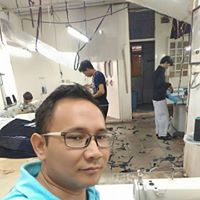Morteza Akbari
age ~66
from Rockledge, FL
Morteza Akbari Phones & Addresses
- 1013 Fieldstone Dr, Melbourne, FL 32940
- 201 Plantation Club Dr, Melbourne, FL 32940
- Rockledge, FL
- Dallas, TX
- Woodstock, GA
- Irving, TX
- Rockledge, FL
Us Patents
-
Structured Smoothing For Superresolution Of Multispectral Imagery Based On Registered Panchromatic Image
view source -
US Patent:7835594, Nov 16, 2010
-
Filed:Dec 1, 2006
-
Appl. No.:11/565707
-
Inventors:Ronald Alan Riley - West Melbourne FL, US
Tariq Bakir - Melbourne FL, US
Adrian M. Peter - Gainesville FL, US
Morteza Akbari - Rockledge FL, US -
Assignee:Harris Corporation - Melbourne FL
-
International Classification:G06K 9/00
G06K 9/40
G06K 9/32
G06K 9/36
G09G 5/00
G09G 5/02 -
US Classification:382299, 382100, 382162, 382254, 382276, 345589, 345606
-
Abstract:Method and system for creating a fused image from an image pair. The method includes obtaining () image data defining a first image of a panchromatic image type and a second image of a multi-spectral image type. The first image has a first spatial resolution and a first spectral resolution. The second image has a second spatial resolution which is lower than the first spatial resolution and a second spectral resolution higher than the first spectral resolution. The first image and the second image are fused () to initialize a fused image having the first spatial resolution and the second spectral resolution. A blurring function is used () to help form the fused image.
-
Panchromatic Modulation Of Multispectral Imagery
view source -
US Patent:7936949, May 3, 2011
-
Filed:Dec 1, 2006
-
Appl. No.:11/565708
-
Inventors:Ronald Alan Riley - West Melbourne FL, US
Tariq Bakir - Melbourne FL, US
Adrian M. Peter - Gainesville FL, US
Morteza Akbari - Rockledge FL, US -
Assignee:Harris Corporation - Melbourne FL
-
International Classification:G06K 9/00
G06K 9/40
G06K 9/32
G06K 9/36
G09G 5/00
G09G 5/02 -
US Classification:382299, 382100, 382162, 382254, 382276, 345589, 345606
-
Abstract:Method and system for creating a fused image from an image pair. The method includes obtaining () image data defining a first image of a panchromatic image type and a second image of a multi-spectral image type. The first image has a first spatial resolution and a first spectral resolution. The second image has a second spatial resolution which is lower than the first spatial resolution and a second spectral resolution higher than the first spectral resolution. The first image and the second image are fused () to initialize a fused image having the first spatial resolution and the second spectral resolution. A point spread function and a set of spectral weights are used to determine scaling factors for scaling () radiance value of pixels defining the fused image in accordance with radiance value of pixels forming the first image and the second image.
-
Geospatial Modeling System For Classifying Building And Vegetation In A Dsm And Related Methods
view source -
US Patent:8503761, Aug 6, 2013
-
Filed:Nov 12, 2009
-
Appl. No.:12/616948
-
Inventors:Morteza Akbari - Rockledge FL, US
Mark Rahmes - Melbourne FL, US
Patrick Kelley - Palm Bay FL, US
Brian Hicks - Melbourne FL, US -
Assignee:Harris Corporation - Melbourne FL
-
International Classification:G06K 9/00
-
US Classification:382154
-
Abstract:A geospatial modeling system may include a geospatial model database configured to store a digital surface model (DSM) of a geographical area, and to store image data of the geographical area. The image data may have a spectral range indicative of a difference between buildings and vegetation. The geospatial modeling system may also include a processor cooperating with the geospatial model database to separate bare earth data from remaining building and vegetation data in the DSM to define a building and vegetation DSM. The processor may also register the image data with the building and vegetation DSM, and classify each point of the building and vegetation DSM as either building or vegetation based upon the spectral range of the image data.
-
Spatial And Spectral Calibration Of A Panchromatic, Multispectral Image Pair
view source -
US Patent:20080129752, Jun 5, 2008
-
Filed:Dec 1, 2006
-
Appl. No.:11/565703
-
Inventors:Ronald Alan Riley - West Melbourne FL, US
Tariq Bakir - Melbourne FL, US
Adrian M. Peter - Gainesville FL, US
Morteza Akbari - Rockledge FL, US -
Assignee:HARRIS CORPORATION - Melbourne FL
-
International Classification:G09G 5/00
-
US Classification:345629
-
Abstract:Method and system for creating a fused image from an image pair comprising a high resolution panchromatic image and lower resolution multi-spectral image. The method includes obtaining image data () defining a first image of a panchromatic image type and a second image of a multi-spectral image type. The first image has a first spatial resolution and a first spectral resolution. The second image has a second spatial resolution which is lower than the first spatial resolution and a second spectral resolution higher than the first spectral resolution. The method also includes a step () of concurrently calculating a point-spread function for down-sampling the first image to the second spatial resolution, and a set of weights for down-sampling the second image to the first spectral resolution.
-
Geospatial Modeling System For 3D Clutter Data And Related Methods
view source -
US Patent:20100182316, Jul 22, 2010
-
Filed:Jan 22, 2009
-
Appl. No.:12/357529
-
Inventors:Morteza Akbari - Rockledge FL, US
Mark Rahmes - Melbourne FL, US -
Assignee:Harris Corporation - Melbourne FL
-
International Classification:G06T 15/20
-
US Classification:345427
-
Abstract:A geospatial modeling system may include a geospatial model database having stored therein an initial three-dimensional (3D) digital surface model of a geographical area, and two-dimensional (2D) clutter data files for respective different types of possible non-building clutter. The geospatial modeling system may also include a processor cooperating with the geospatial model database to generate an updated digital surface model including 3D clutter data within and being based upon the initial digital surface model and the 2D clutter data files.
-
Accuracy-Based Significant Point Derivation From Dense 3D Point Clouds For Terrain Modeling
view source -
US Patent:20130144565, Jun 6, 2013
-
Filed:Dec 1, 2011
-
Appl. No.:13/308853
-
Inventors:Stephan W. Miller - Melbourne FL, US
Jeffrey W. Houser - Melbourne FL, US
Mark Rahmes - Melbourne FL, US
Morteza Akbari - Rockledge FL, US -
Assignee:HARRIS CORPORATION - Melbourne FL
-
International Classification:G06F 17/50
-
US Classification:703 1
-
Abstract:Method includes calculating a mean z coordinate value for points within the point cloud. An initial set of points is selected which have z coordinate values which deviate from the mean by at least an initial value. Thereafter, a triangulated irregular network (TIN) is constructed using the initial set of points. The method continues by determining if there is a significant point that exists among the points contained within an x, y extent of each triangle. If so, the TIN is updated to include the initial set of points and any significant points determined to exist within the triangles that form the TIN. Thereafter, the method continues by repeating the determining and the updating steps until there are no additional significant points found within the triangles.
-
Fractal Method For Detecting And Filling Data Gaps Within Lidar Data
view source -
US Patent:20130202193, Aug 8, 2013
-
Filed:Feb 3, 2012
-
Appl. No.:13/365835
-
Inventors:Mark Rahmes - Melbourne FL, US
J. Harlan Yates - Melbourne FL, US
Morteza Akbari - Rockledge FL, US
Gnana B. Tenali - Melbourne FL, US -
Assignee:HARRIS CORPORATION - Melbourne FL
-
International Classification:G06K 9/00
-
US Classification:382154
-
Abstract:Method for improving the quality of a set of a three dimensional (3D) point cloud data representing a physical surface by detecting and filling null spaces (). The method includes analyzing () the data to identify the presence of a plurality of level 1 fractals (), each defined by a plurality of voxels () containing data points arranged in one of a plurality of three-dimensional patterns. The method also includes selectively filling () voxels in the 3D point cloud data with a first predetermined limited number of data points to increase a number of instances where level 2 fractals () can be used for representing the 3D point cloud data. Each level 2 fractal is defined as a common plurality of the level 1 fractals having a common three-dimensional pattern, where the common plurality of level 1 fractals are also arranged in accordance with the common three dimensional pattern.
-
Method For Hydrocarbon Recovery With A Fractal Pattern And Related Apparatus
view source -
US Patent:20180202262, Jul 19, 2018
-
Filed:Feb 5, 2018
-
Appl. No.:15/888639
-
Inventors:- MELBOURNE FL, US
MORTEZA AKBARI - ROCKLEDGE FL, US
MIKE MCGONAGLE - MELBOURNE FL, US
MARK BLUE - PALM BAY FL, US -
International Classification:E21B 41/00
G01V 3/12
G01V 9/00 -
Abstract:A method for predicting hydrocarbon recovery in a subterranean formation may include generating pre-heating data associated with fracturing in a sample from the subterranean formation, determining a first fractal pattern based upon the pre-heating data, and heating the sample with RF power to cause additional fracturing in the sample. The method may include generating post-heating data associated with additional fracturing in the sample after heating with RF power, determining a second fractal pattern based upon the post-heating data, detecting change between the first fractal pattern and the second fractal pattern, and predicting hydrocarbon recovery from the subterranean formation based upon the detected change.
Resumes

Morteza Akbari
view sourceSkills:
Microsoft Excel
Healthcare
Customer Service
Microsoft Word
Microsoft Office
Product Development
Product Management
Sales Management
Healthcare
Customer Service
Microsoft Word
Microsoft Office
Product Development
Product Management
Sales Management

Morteza Akbari
view source
Morteza Akbari
view source
Morteza Akbari
view source
Morteza Akbari
view sourceFlickr

Mohamad Morteza Akbari Sohi
view source
Morteza Akbari
view source
Morteza Akbari
view source
Morteza Akbari
view source
Morteza Akbari
view source
Morteza Akbari
view source
Morteza Akbari
view source
Morteza Akbari
view sourceMyspace
Youtube
Googleplus

Morteza Akbari

Morteza Akbari

Morteza Akbari

Morteza Akbari

Morteza Akbari

Morteza Akbari

Morteza Akbari

Morteza Akbari
Get Report for Morteza Akbari from Rockledge, FL, age ~66












